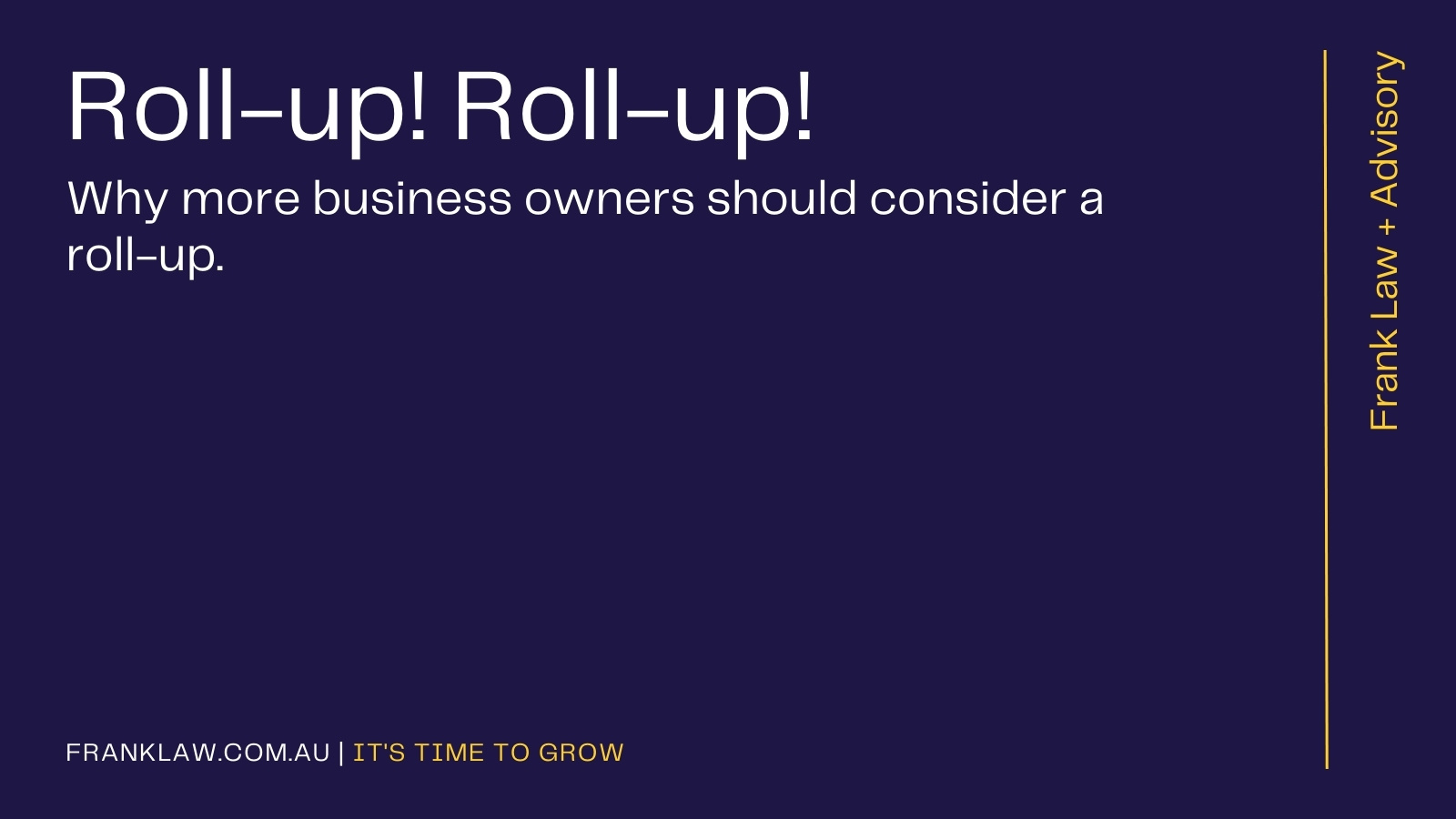When I mention “roll-up” to a client, there is often a pause. This pause signifies a deep level of nostalgia, remembering a time when the lunchbox would open at school and reveal an Uncle Toby’s Roll-Up. This edible roll-up shares some similarities to a business roll-up, including:
- They are appealing.
- They are sticky; and
- They come with a warning.
What is a roll-up?
A rollup is a process where multiple small companies in the same market or industry are acquired and merged.
Usually, a roll-up strategy is engineered by a financial buyer such as a private equity firm, family office or industry player. They identify that the industry is fragmented, and synergies exist should multiple businesses be brought together.
In each case, the roll-up usually starts with a platform business. This is a business within the industry that has some size and substance to it. It usually has a good reputation and is well regarded in the industry and market by its peers. The owners are usually technical and know other key players in the industry. They are what we call industry ‘door openers’.
The fundamental idea that underpins the roll-up is that bigger is better. A bigger company can reduce actual unit costs because of shared resources, increase market shares because of size and attract a higher transaction multiple as a result.
Branded Group or Group of Brands?
In each roll-up strategy, one must decide whether the approach will be a branded group or a group of brands strategy.
A branded group strategy involves acquiring businesses and bringing them into a group. In a simplistic way, the new business becomes part of a much larger group. The branding is changed, emails are changed, and the old business dies out over a period of time. This branded group strategy works well when there is a clear branding winner in the industry and where clients are bound by more than just a brand, like contracts etc. An example of this is Kelly Partners. They acquire accounting firms and bring them into the brand. The clients of each firm are linked via relationships and engagements. The brand enables leverage and marketing efficiency.
A group of brands strategy involves acquiring businesses and keeping their brands. In this case the brands remain but there are synergies that are extracted such as marketing, admin costs, customer data flow and supplier negotiations. An example of this is the Healthia Group. They acquire allied health businesses and partner with owners to help run them whilst promoting the known local brand. This strategy works well when locality and personality are critical.
Roll-ups are appealing.
Like their edible namesake, roll-ups are appealing. When done well, they can be extremely effective. An owner who knows an industry and can extract the synergies, can create a powerful combined and consolidated business. The idea of bolting on another business similar to the main business, can catapult the businesses growth to another level. Regional or state expansion can be a whole lot easier when you acquire rather than start.
The financial economics are also appealing. Usually, the roll-up will involve cost reductions across the group as functions will be duplicated. If the acquiring company has a finance team, it is unlikely that they will need to take all the targets finance team. Naturally this would result in headcount and an increase to underlying profitability. Similarly, if the target has equipment or customers that could benefit the acquiring company then income synergies can be extracted to increase group revenue per client.
Ultimately, the key appealing nature of the rollup is increase in revenue, profit and multiple of exit.
I have included a worked example at the end to illustrate this point in more detail.
Roll-ups are sticky.
The key difference between a well-executed roll-up and a poorly executed roll-up is the integration piece. As most roll-ups involve a large people component (staff and customers) this aspect can be tricky and sticky to manage.
Some of the integration might result in better outcomes for employees whilst other aspects might be viewed as a step backwards. In my view this is the reason why the rollup should be implemented first by an industry insider who can manage values and company direction which ultimately involves people rather than a pure financial buyer who might simply look at the P&L.
The flip side is that the scale can present customers with comfort. The larger the business the less likely you are to fail in many people’s eyes. This may result in more orders being placed, more discussions as to contracted revenue and more ability to serve that customer. This can result in much more sticky customer relationships than if the entity was smaller and of less scale.
Each roll-up is different and will need to be examined in light of the upside and the downsides.
Roll-ups come with a warning.
Like the edible version, a roll-up comes with a warning. Do it poorly and you can erode value far quicker than you can create it.
Just like when a roll-up gets stuck in your teeth and creates a cavity, a poorly integrated roll-up can create a group of terrible parts that are working against each other.
People will become unhappy; customers will leave and ultimately you will be plugging holes whilst treading water.
To mitigate this, I suggest there are 4 key things that need to be done BEFORE you start a roll up. They are:
- Get your house in order.
- This means ensuring that your systems and processes are in order. This means getting your financials in order and treating the business like a business not a personal piggy bank.
- Get your vision and values clear.
- Be super clear about your vision and the values you wish to impart. This is so that each new business can be indoctrinated and brought along for the journey.
- Get clear on your strategy and the why.
- Be clear on what type of roll-up and the why. If it’s purely financial that is fine but drill down as to what that looks like. The strategy aspect matters most when it comes to integration and working through efficiencies and synergies.
- Get your deal team sorted.
- This is a no brainer but get the deal team sorted. Be clear as to expectations, speed and how to go about this. What marks a good target vs bad? Clarity, effectiveness and efficiency are key.
Worked Illustration
To illustrate an example, let’s take a small managed IT provider. They are currently generating $4m in revenue and $1m of EBITDA ('Earnings Before Interest, Taxes, Depreciation and Amortisation'). If that business were to sell today, they may attract a 3 to 5 x multiple depending on the underlying strength of their contracts, the length of the contracts and who the acquirer was. The likely buyer would be a roll-up player or a private individual. Private equity is mostly out due to size.
If that business were to go and effect a roll-up and acquire 3 similarly sized businesses where 15% of costs could be saved per business, then the business would have:
- $12m in revenue,
- $4m in EBITDA (pre-cost savings)
- $1.8m in cost saving synergies
- EBITDA of $5.8m per annum (post synergies).
To get to this point, the acquiring business has spent $9m ($3m cash plus $6m debt) on acquisitions to obtain $4.8m of adjusted EBITDA (post cost saving synergies) which is an effective multiple of 1.9 times.
The group now makes $5.8m EBITDA on $12m revenue.
This business now has the free cashflow to ensure the right level of management is in place and to present the business as a highly profitable, well optimised business ready for investment.
If this business went to market it would likely attract private equity at a 5 to 6 x multiple to be the platform and to use a greater capital pool to speed up the next phase of the roll-up.
At a 5 to 6 x multiple, this business could worth $29m to $34.8m less debt ($6m). If the founder sold down 60% they would realise $14m to $17.3m and retain 40%.
Pushing the illustration further, lets fast forward 5 years. The private equity firm has injected a further $20m in equity across 20 transactions resulting in:
- $80m increase in topline revenue.
- $8m cost saving synergies across the targets.
- $28m increase to EBITDA
- $60m increase to debt.
At year 6 the group is placed on the market by the private equity firm with the following metrics:
- $100m revenue.
- $32m EBITDA.
- $60m debt.
This business now trades at a 7-9x multiple and so, fetches between $224m - $288m less debt ($60m).
The business owner who kicked this off still retains 25% post dilution and so will receive on sale between $41m - $57m bringing total consideration across the 2 deals to between $55m to $74m.
The private equity firm invested between $34m - $37.3m and returned between $123m - $171m or 3.6 to 4.6 x their money.
Whilst this is an outrageously perfect roll-up, and very few look like this, the concept and theory work.
Summary
The roll-up should be considered by more SME owners as a way to create a significantly greater capital event through leveraging their network and their knowledge in a short space of time.
We, at Frank Law + Advisory, have designed and are currently executing roll-up strategies across several different industries for our clients. We believe that implementing a methodical process can accelerate acquisitions and smooth out integration issues. Having been through a number of challenging acquisitions, we are perfectly suited to navigate the roll-up process, ensuring that the House is in Order; the Values and Vision are clear; the strategy and the why are known; and the deal team is engaged.
If you would like to have a chat regarding how to effect a roll up in your industry, then reach out! We are always keen to chat.
.png?width=5850&height=716&name=5%20(1).png)




